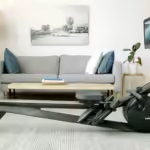Investing in exercise equipment for your home or gym can be a significant financial commitment. To make the most of that investment, it’s essential to keep your machines in top condition. Regular maintenance not only ensures that your equipment performs at its best but also extends its lifespan, saving you money in the long run. In this guide, we’ll cover practical tips on how to extend the lifespan of your exercise equipment with proper care.
Regular Cleaning to Prevent Wear and Tear
One of the easiest and most effective ways to extend the life of your exercise equipment is by keeping it clean. Dust, sweat, and dirt can build up on and inside your machines, leading to corrosion, rust, and malfunctioning parts over time.
How to Clean Exercise Equipment Properly:
- Wipe Down After Each Use: Sweat contains salt, which can lead to rust and corrosion if left on metal surfaces. Use a soft cloth to wipe down handles, seats, and other touchpoints after each use.
- Use Non-Abrasive Cleaners: Harsh chemicals can damage the protective coatings on your equipment. Use mild, non-abrasive cleaners designed for gym equipment or a mixture of water and mild detergent.
- Vacuum Regularly: Dust can accumulate in the crevices and moving parts of machines like treadmills, bikes, and ellipticals. Vacuum around and under your equipment regularly to keep dirt at bay.
- Clean Screens and Consoles: If your equipment has digital displays, use a microfiber cloth to gently clean them without scratching the surface.
Regular cleaning ensures that your machines run smoothly and look good, preventing small issues from escalating into major repairs.
Lubricate Moving Parts to Reduce Friction
Exercise equipment, especially treadmills, ellipticals, and stationary bikes, rely on moving parts to function efficiently. Over time, friction between these parts can cause wear and tear, leading to breakdowns. Lubricating these parts regularly is a key aspect of maintenance.
Lubrication Tips:
- Consult the User Manual: Different machines require different types of lubrication. Always check the manufacturer’s guidelines for the recommended lubricants.
- Lubricate Treadmill Belts: One of the most common areas that need lubrication is the treadmill belt. Apply a lubricant between the belt and the deck every three to six months, depending on usage.
- Elliptical and Bike Joints: Ellipticals and stationary bikes have joints and bearings that require regular lubrication to reduce wear. Grease or oil these parts based on the manufacturer’s recommendations.
- Use Silicone-Based Lubricants: Silicone-based lubricants are usually preferred for most gym equipment as they are durable and reduce friction effectively without attracting dust.
Lubricating moving parts will keep your machine running smoothly and quietly, ensuring that your workouts are comfortable and your equipment lasts longer.
Check for Loose Bolts and Screws
Over time, the vibration from exercise machines can cause bolts and screws to loosen, which can lead to wobbly or unsafe equipment. Performing regular checks and tightening loose bolts is crucial for both safety and longevity.
Maintenance Routine for Bolts and Screws:
- Monthly Inspections: Check your equipment monthly for any loose screws or bolts. Pay special attention to areas that endure significant movement or weight, such as treadmills’ bases, elliptical arms, or the seat and handle adjustments on bikes.
- Use the Right Tools: Always use the correct tools, such as wrenches or screwdrivers, to avoid over-tightening or stripping bolts, which can weaken the machine’s structure.
- Replace Worn Fasteners: If a bolt or screw is worn or stripped, replace it immediately with one that matches the manufacturer’s specifications.
By regularly inspecting and tightening bolts, you’ll prevent unnecessary stress on the machine’s frame, ensuring it stays stable and secure for years to come.
Replace Worn Parts Promptly
No matter how well you care for your equipment, some parts are bound to wear out over time. Components such as belts, cables, pedals, and resistance bands are especially prone to wear and tear due to frequent use. Replacing these parts promptly can save you from bigger, costlier repairs later on.
Common Parts to Keep an Eye On:
- Treadmill Belts and Decks: If your treadmill belt starts to slip, fray, or make unusual noises, it’s time to replace it. Similarly, the treadmill deck may need replacing after years of heavy use.
- Elliptical and Bike Pedals: Check for signs of wear or damage on pedals. If they are cracked, loose, or unstable, replace them to avoid safety hazards.
- Cables and Pulleys: Strength training machines with cables and pulleys can suffer from frayed or worn cables. Replace them at the first sign of wear to prevent accidents.
- Resistance Bands and Springs: For machines that use resistance bands or springs, regularly inspect them for signs of overstretching or wear and replace them as needed.
Being proactive about replacing worn parts will keep your machine running efficiently and prevent breakdowns, which can lead to costly repairs.
Keep Your Equipment in a Suitable Environment
The environment in which you keep your exercise equipment plays a significant role in how long it lasts. Excessive humidity, heat, or cold can negatively impact its components, leading to rust, corrosion, and other forms of damage.
Tips for Storing Your Exercise Equipment:
- Avoid Humid Areas: Humidity can cause rust on metal parts and damage electrical components. Keep your equipment in a dry, climate-controlled space.
- Temperature Control: Extreme temperatures can damage plastic, rubber, and metal components. Avoid placing your equipment in areas prone to freezing or overheating, such as garages or outdoor patios.
- Use a Protective Cover: If your equipment is stored in a place where it can collect dust or be exposed to the elements, use a protective cover to shield it from damage.
Storing your equipment in a well-ventilated, temperature-controlled environment will ensure its longevity and help avoid unexpected repairs.
Follow the Manufacturer’s Maintenance Schedule
Most exercise equipment comes with a user manual that includes a recommended maintenance schedule. Following these guidelines can prevent unnecessary damage and extend the life of your equipment.
Manufacturer’s Recommendations to Keep in Mind:
- Routine Checkups: Some manufacturers recommend specific intervals for lubrication, part replacement, or cleaning. Sticking to these schedules helps prevent premature wear.
- Warranty Guidelines: Regular maintenance, as outlined by the manufacturer, ensures that your warranty remains valid. Neglecting these guidelines may void your warranty, leaving you to cover repair costs out of pocket.
By adhering to the manufacturer’s maintenance instructions, you can avoid damage and ensure that your machine continues to operate smoothly.
Conclusion
With proper care and regular maintenance, your exercise equipment can last for many years, providing a high return on your investment. Cleaning regularly, lubricating moving parts, checking for loose bolts, replacing worn parts, storing the equipment in the right environment, and following the manufacturer’s guidelines are all essential steps to extend the lifespan of your machines.Don’t wait until your equipment breaks down. By being proactive, you’ll not only save on repair costs but also enjoy safe, effective workouts for years to come..


